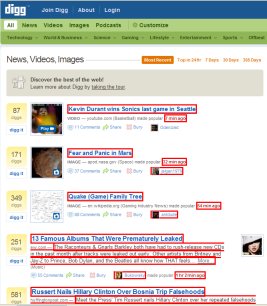
RDFa seems to be picking up more momentum in the last few weeks. The formerly skeptical Taylor Cowan is liking it more, and I learned from the RDFa blog that Digg has lots of RDFa—five triples of information for some stories, so there are some simple but cool applications waiting to be written around those.
I was a little behind in taking advantage of the RDFa bookmarklets, but Ben Adida pointed me to them when I asked about an up-to-date RDFa extractor. I set the GetN3 one to send the N3 triples right to Emacs, and it's great when looking at a web page like Digg's home page to click a button and see all the triples appear in Emacs.
The first few times I tried the RDFa Highlight bookmarklet, which puts red rectangles around all the parts of a web page that have RDFa metadata assigned, I didn't think it was very useful; I thought, OK, red rectangles, what can I do with them? My experience with Digg changed my mind. A single button click gives a very quick and intuitive display of how much RDFa a page offers to work with.
Ironically, the RDFa bookmarklets page has no RDFa in it as I write this. My blog's home page has very little, and the bookmarklets can't seem to find it, but they work fine on my Permalink pages (like this one), which have a bit more anyway.

